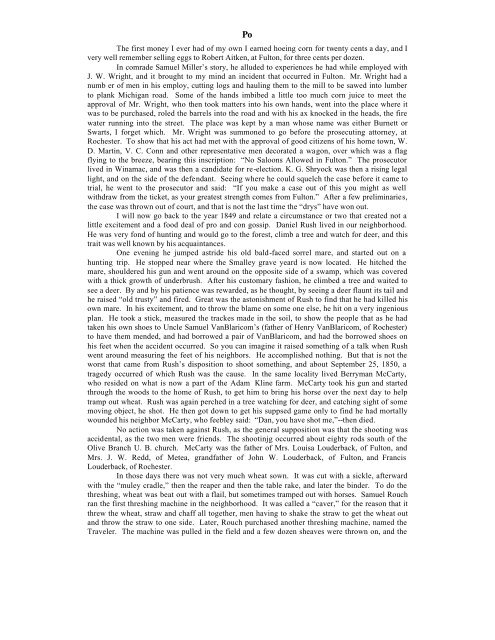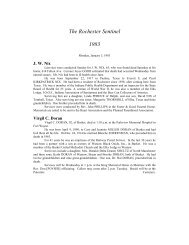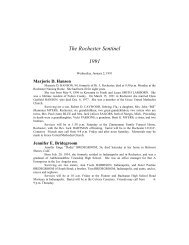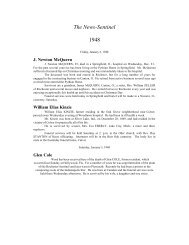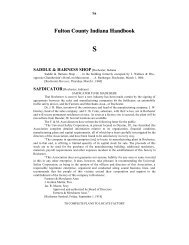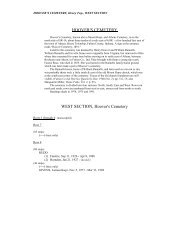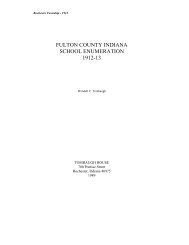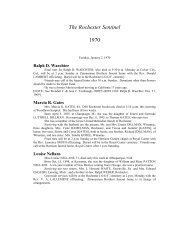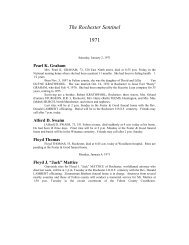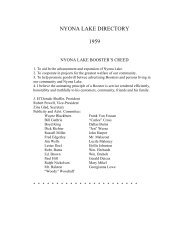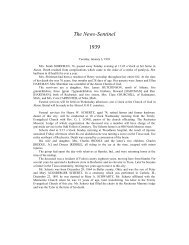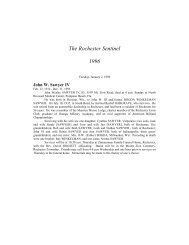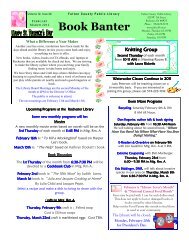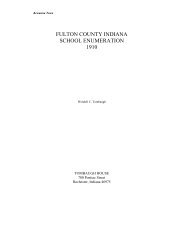Handbook N-P - Fulton County Public Library
Handbook N-P - Fulton County Public Library
Handbook N-P - Fulton County Public Library
You also want an ePaper? Increase the reach of your titles
YUMPU automatically turns print PDFs into web optimized ePapers that Google loves.
Po<br />
The first money I ever had of my own I earned hoeing corn for twenty cents a day, and I<br />
very well remember selling eggs to Robert Aitken, at <strong>Fulton</strong>, for three cents per dozen.<br />
In comrade Samuel Miller’s story, he alluded to experiences he had while employed with<br />
J. W. Wright, and it brought to my mind an incident that occurred in <strong>Fulton</strong>. Mr. Wright had a<br />
numb er of men in his employ, cutting logs and hauling them to the mill to be sawed into lumber<br />
to plank Michigan road. Some of the hands imbibed a little too much corn juice to meet the<br />
approval of Mr. Wright, who then took matters into his own hands, went into the place where it<br />
was to be purchased, roled the barrels into the road and with his ax knocked in the heads, the fire<br />
water running into the street. The place was kept by a man whose name was either Burnett or<br />
Swarts, I forget which. Mr. Wright was summoned to go before the prosecuting attorney, at<br />
Rochester. To show that his act had met with the approval of good citizens of his home town, W.<br />
D. Martin, V. C. Conn and other representative men decorated a wagon, over which was a flag<br />
flying to the breeze, bearing this inscription: “No Saloons Allowed in <strong>Fulton</strong>.” The prosecutor<br />
lived in Winamac, and was then a candidate for re-election. K. G. Shryock was then a rising legal<br />
light, and on the side of the defendant. Seeing where he could squelch the case before it came to<br />
trial, he went to the prosecutor and said: “If you make a case out of this you might as well<br />
withdraw from the ticket, as your greatest strength comes from <strong>Fulton</strong>.” After a few preliminaries,<br />
the case was thrown out of court, and that is not the last time the “drys” have won out.<br />
I will now go back to the year 1849 and relate a circumstance or two that created not a<br />
little excitement and a food deal of pro and con gossip. Daniel Rush lived in our neighborhood.<br />
He was very fond of hunting and would go to the forest, climb a tree and watch for deer, and this<br />
trait was well known by his acquaintances.<br />
One evening he jumped astride his old bald-faced sorrel mare, and started out on a<br />
hunting trip. He stopped near where the Smalley grave yeard is now located. He hitched the<br />
mare, shouldered his gun and went around on the opposite side of a swamp, which was covered<br />
with a thick growth of underbrush. After his customary fashion, he climbed a tree and waited to<br />
see a deer. By and by his patience was rewarded, as he thought, by seeing a deer flaunt its tail and<br />
he raised “old trusty” and fired. Great was the astonishment of Rush to find that he had killed his<br />
own mare. In his excitement, and to throw the blame on some one else, he hit on a very ingenious<br />
plan. He took a stick, measured the trackes made in the soil, to show the people that as he had<br />
taken his own shoes to Uncle Samuel VanBlaricom’s (father of Henry VanBlaricom, of Rochester)<br />
to have them mended, and had borrowed a pair of VanBlaricom, and had the borrowed shoes on<br />
his feet when the accident occurred. So you can imagine it raised something of a talk when Rush<br />
went around measuring the feet of his neighbors. He accomplished nothing. But that is not the<br />
worst that came from Rush’s disposition to shoot something, and about September 25, 1850, a<br />
tragedy occurred of which Rush was the cause. In the same locality lived Berryman McCarty,<br />
who resided on what is now a part of the Adam Kline farm. McCarty took his gun and started<br />
through the woods to the home of Rush, to get him to bring his horse over the next day to help<br />
tramp out wheat. Rush was again perched in a tree watching for deer, and catching sight of some<br />
moving object, he shot. He then got down to get his suppsed game only to find he had mortally<br />
wounded his neighbor McCarty, who feebley said: “Dan, you have shot me,”--then died.<br />
No action was taken against Rush, as the general supposition was that the shooting was<br />
accidental, as the two men were friends. The shootinjg occurred about eighty rods south of the<br />
Olive Branch U. B. church. McCarty was the father of Mrs. Louisa Louderback, of <strong>Fulton</strong>, and<br />
Mrs. J. W. Redd, of Metea, grandfather of John W. Louderback, of <strong>Fulton</strong>, and Francis<br />
Louderback, of Rochester.<br />
In those days there was not very much wheat sown. It was cut with a sickle, afterward<br />
with the “muley cradle,” then the reaper and then the table rake, and later the binder. To do the<br />
threshing, wheat was beat out with a flail, but sometimes tramped out with horses. Samuel Rouch<br />
ran the first threshing machine in the neighborhood. It was called a “caver,” for the reason that it<br />
threw the wheat, straw and chaff all together, men having to shake the straw to get the wheat out<br />
and throw the straw to one side. Later, Rouch purchased another threshing machine, named the<br />
Traveler. The machine was pulled in the field and a few dozen sheaves were thrown on, and the


